Outlander proves Mitsubishi is alive and well
Filed under: Weekly test drives, Autos, Uncategorized
By John Gilbert
It seemed like it took most of a year before I got a chance to test drive a 2022 Mitsubishi Outlander SUV, and it was as much a relief to get one from Mitsubishi’s Midwest test fleet as it was to drive the midsize vehicle with what to me is a familiar name.
The Outlander has been completely redesigned, with a new platform and new engine and interior, to go along with the smaller Outlander Sport, and the even more-compact Eclipse Cross. I had feared that Mitsubishi might decide to quit marketing its vehicles in the U.S. because of the stiff competition worldwide.
I am pleased to see a resurgence in Mitsubishi vehicles. When I started analyzing and writing about new cars back in the late 1960s, it was an exciting crossroads of the industry, with some awkward and outdated American cars indignantly trying to hold off the arrival of high-mileage and high-tech imports from Japan.
Honda, Toyota, Nissan, Mazda and Subaru were trying to find their way into the U.S. market. So was a very impressive conglomerate known as Mitsubishi, made an arbitrary decision to go with Chrysler Corporation to produce some of its subcompacts like the Dodge Colt, and an amazingly durable and dependable 3.0-liter V6 that Chrysler put into various cars such as their Caravan and Voyager minivans. Those minivans were about to take over the family marketplace, and those bullet-proof engines were a big reason for their success. We have friends who put well over 200,000 on them, then gave them to their kids for another 100,000 economical miles.
Mitsubishi also built a subcompact, known as the Mirage, which in the U.S. became Dodge Colts and Plymouth Champs. They were fun and quick, and delivered over 40 miles per gallon, while the minivans were proving bulletproof.
I road-raced a Dodge Colt in the Sports Car Club of America’s new Showroom Stock category for that summer of 1970, using a Colt set up by White Bear Dodge for amateur competition. I learned a lot about road-racing when I battled a veteran driver and beat him for second place in a timed race around Donnybrooke Speedway’s 3-mile course, after which I was flattered to get the award for fastest race lap. Only then did it occur to me that if I turned the fastest lap, why was I fighting for socond instead of first?
I was impressed enough with Mitsubishi’s engineering that we bought a Colt station wagon for our young family, and later a Colt hatchback, on which y0u could screech the tires in the first three gears and still get 43 miles per gallon. As years passed, I also learned that Mitsubishi built the best electronics in the industry through its MGA televisions, tuners and speaker systems, and we enlisted in them, too.
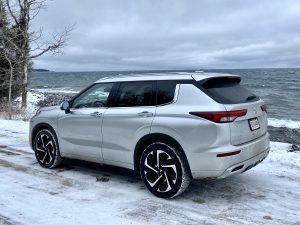
Outlander is reinforced as the iconic top model for Mitsubishi, with even a tight third row of seats.
The arrangement dissolved as Chrysler wound up being bounced around by various investor-owners, and stand-alone Mitsubishi dealerships faded and disappeared from a lot of cities, including Duluth, Minnesota, where we now live, and where a thriving dealership was eliminated and consumers had to search the Twin Cities to find a Mitsubishi dealership.
So the 2022 Outlander carries Mitsubishi’s hopes of expanding its reach in the U.S.,, and reports have been positive. Our test Outlander carried a sticker price of $35,295, which puts it right among its competition, although the Outlander was filled with feature options.
The similarity of cars and SUVs these days is such that many of them look alike, and to stand out means to incorporate some unusual styling. The Outlander has done just that, with a prominent grille outlined at the top by sleek, thin LED lights, which curve artfully around to outline the upper grille and descend to also isolate the small blocks of LED lights on either side of the lower grille. The lights themselves are outstanding, as well as certainly distinctive.
Surprisingly, for such a blunt compact, there is actually a third row seat, which must have required a masterstroke of engineering just to wedge it in back there. We never folded the seat up, choosing to leave it down in case we had a large supply of groceries. Maybe that’s perfect, because if you need to seat seven, two or them will have to be small children, who would love to have their own kid-size seats.
As the old saying goes, better to have it and not need it than to need it and not have it.
From the side, or rear, the Outlander’s graceful lines are more conventional, which is fine because its identity is in its face. Inside, the white quilted leather seats are encapsulating, and the shifter meets what seems to have become an obligatory complexity in simply moving your choice from park to drive or neutral or reverse. In the Outlander, it is less obtrusive and you learn to rock your finger fore or aft to find your desired gear. There is a large information screen mounted nice and high in the center of the dash, and you can find more information than an ordinary driver can want.
Under the hood, Mitsubishi has installed its new 4-cylinder engine, measuring 2.5 liters in displacement with a nicely balanced 181 horsepower and identical figure for torque, which collaborate to make the Outlander quick enough and sporty enough for a family hauler. It is annoying to try to find a CVT (continuously variable transmission) that is anything but boring, but in the Outlander, large paddles on either side of the steering wheel allow you to shift through eight stops on the CVT, and if you use the paddles adroitly, you can forget you even have a CVT in the thing.
Some have accused the Outlander of leaning too far on turns, but I found it just right — better than an overstuffed vehicle but tastefully short of being racy. The EPA estimates show 24 miles per gallon city and 30 in highway driving, and we got 32 or 33 on combined but mostly city driving. Our gauge showed 32.6, for example.
It’s also evident that Mitsubishi is heading toward hybrid and electric power, and I await any plans that may be coming.
Mitsubishi maintains the tradition of offering something beyond the normal technology, and an example might be that instead of just calling it “all-wheel-drive,” the Outlander’s system is called “Super All-Wheel Control.” There are some creative ways of executing, with adjustments for setting your drive mode.
We did some experimenting on some hard ice to see exactly what difference the change in modes might make. With my son, Jack, standing outside the car to observe me on a slab of ice, I tried accelerating hard in normal, and in the slippery setting. In normal, all four wheels spun immediately in chorus; in slippery, the front wheels spun for a couple revolutions, and after a momentary delay the rear ones started to spin, too.
In overview, the new Outlander lives up to its redesign scheme by looking unique, and it lives up to Mitsubishi’s reputation of adding a few new wrinkle to the drivetrain and shifting process. It passes all the tests for comfort and economic efficiency as well, and its audio system is as good as anticipated.
For me, of course, it’s also a tremendous benefit just to know Mitsubishi is still selling vehicles in the U.S. and its positive sales since the Outlander’s redesign mean good things for the future.
Bronco versatility includes 2-door, stick shift
Filed under: Weekly test drives, Autos, Uncategorized
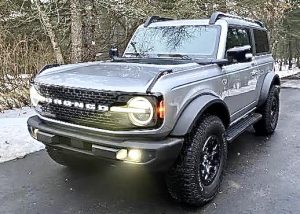
Larger than the Bronco Sport, the “regular” Bronco is roomier, more rugged, and has a 2-door version.
By John Gilbert
Auto companies can baffle us with the manipulation of introductions, and the most recent example is the highly popular Ford Bronco, which revives the name of the company’s original SUV workhorse, loaded up with modern technology. If I didn’t know better, I might have thought Ford created more questions than it answered when it brought out a string of the versatile and useful Bronco, although I enjoyed all the different versions I drove.
How could you not enjoy the Bronco Sport, a tight little 4-door SUV capable of handling all your objectives for family SUV duties or light off-roading? And then I got a second one, also a Bronco Sport, and also fun to operate. And later still, I got one with a stick shift that was a bit more work/off-road oriented, with a slick-shifting 7-speed manual. After all that, I got the bigger Bronco, not the Bronco Sport, and in 2-door fashion.
I knew that Ford also was bringing out a larger Bronco a bit later than the Bronco Sport, with more interior room, and the ability to haul more people and stuff. So about the time I figured out the 4-door Bronco, I got a couple different 2-door models, and they also were fun to drive, and felt sportier.
If you aren’t slightly confused by now, maybe you haven’t been paying close attention. I eagerly hopped into the most recent Bronco, realizing immediately something was different. That was because it was a 2-door, after all the earlier ones of both were 4-doors.
The 4-door is well made and takes care of business efficiently. But, c’mon — don’t we all harbor secret fantasies about having a 2-door SUV? I know I have.
The first 2-door model I had was the stick shift! Ford has equipped some Broncos with a 7-speed stick, and that gives you the ability to keep it right where you want it no matter what your intentions are. Fortunately, the second one I got came equipped with the 10-speed automatic, a smooth-shifting unit that is perfectly set up for the equipment at hand and offered a comparison.
The Bronco 2-door Advanced 4X4 was the “Black Diamond” model and felt light and quick, and came with a 2.3-liter EcoBoost twin turbocharged 4-cylinder engine. The stick was remarkably smooth to shift and accelerated out of trouble with ease. It has 275 horsepower and 315 foot-pounds of torque.
The hill-start assist is a neat feature, with a stick, because it puts you at ease when you stop on a hill, sure that the vehicle won’t start rolling backward while you’re heel-and-toeing at a stoplight short of the crest.
That’s particularly handy if you’ve gotten a little rusty in your heel-and-toe skills with a stick and a clutch. It also had what Ford calls “full vehicle steel bash plates.”
The 2-door gives you a spacious rear seat, although getting into it requires some agility.
The Black Diamond trim is neat and gives you some dded features, including an optional removable roof. Ford wants the Bronco to tackle the same off-road projects as the Jeep Wrangler, so it starts out by making it available with doors that pop off, in addition to the roof, so you can go cavorting around doorless and topless, if that suits you. Also in the concept of stripping it down for hardy use, the side mirrors come affixed to the frame itself, rather than on the door, which always seems to cause more vibration and need for adjustment. No adjustment needed, in this case, even if the doors are back home in the garage.
The Bronco 2-door with the 10-speed automatic was equipped with the Wildtrak package, which means, in my tester’s case, a 2.7-liter EcoBoost V6, with lots of excessive power, compared to the 2.3-liter 4. The V6 lists 315 horsepower and 410 foot-pounds of torque, at a sticker price of $53,650.
Curiously, the larger engine with the automatic didn’t feel as quick as the four with the stick.
One of the features that attracts folks to the Bronco is the array of gadgets that make it seem like a good deal, such as the cargo area protectors, the black roof rails, and the neat LED headlights that shine in a tight pattern even though appeareing to be squinting just a bit. The heavy duty floormats can be hosed off for cleaning if your off-roading includes acquiring a bit of mud inside and out.
When I first saw the array of Broncos, I wasn’t sure where I stood. But the stick-shift 2.3-liter version lists for $42,720, as equipped, while the 2.7 V6 model lists for $53,650. Both have distinct personalities, after you realize there are some differences.
The smaller Bronco Sport, with four doors, makes any selection a tough choice. Among the impressive advancements in modern cars is that some of the new 4s perform right up there with the usual V6es, and some of the new automatics seem to work as efficiently as the best stick shifts. Such modern automatics work so smoothly that they can relegate the stick shifts to the discard pile. Unless, that is, you like stick shifts as much as I do.
In the case of the Bronco family, the stick can make the 4-cylinder feel quicker and deliver better fuel economy than the V6. In that manner, the stick makes the 4-cylinder function like old-time off-roaders, even ones originally called Broncos.
That is especially so if you take the doors off and let it all hang out, so to speak.
BMW engine boosts Supra to new Toyota image
Filed under: Weekly test drives, Autos, Uncategorized
By John Gilbert
The idea that folks at Toyota are going through a “second childhood” takes root from the fact that the Japanese auto giant has hit the market with several sports coupes, convertibles and racy vehicles in the last few years. The upscale Lexus LC500 was the subject of my review here just a few weeks ago, as the 6-figure pinnacle of luxury-performance, and now, before October gets far enough along to threaten us with some foul weather, we’ve got to also check out the 2021 Toyota Supra and declare it the company’s bargain luxury-sports car.
Actually, the bargain sports car of the Toyota line is the unfortunately-named Toyota 86, an under-$30,000 sports car built jointly with Subaru, using Subaru engines, and almost identical to the Subaru BRZ.
The new Supra is a completely different story. If working a jont-venture with Subaru was a good idea for a low-slung sports car, then working the magic combination with BMW to come up with the Supra is even better, and a mid-$50,000 price point is a comparative bargain when you know you’ve got the same 3.0-liter inline 6 made by BMW for its new M4 sporty coupe.
The Supra is a grand old name in Toyota lore, starting as a stretched out luxury model of the Celica coupe three decades ago, and it persisted as a powerful sporty cruiser with a potent Toyota in-line 6 and all of the company’s advancing technology. Toyota even stretched the Supra out into a “2 plus 2” model with a jump-seat behind the two buckets.
Times change, and with its new upscale Lexus brand also needing vehicles, the Supra disappeared from the U.S. market just over 20 years ago. Toyota now is on a movement to shed its stodgy, conservative image, and after its Lexus sports cars and sportier leaning of Toyotas, the company brought back the Supra name on an exotic-looking new sports coupe as the fifth-generation Supra for 2020.
The look of the Supra didn’t dazzle men when it first came out for 2020. I knew it was something of a composite vehicle jointly created by Toyota and BMW, giving it legendary heritage from two international automotive legends. But it had this extra-prominent nose that I thought made it look, well…ugly.
Anyhow, after a few slight revisions, a 2021 model of the Supra showed up for me to test drive, up and down the North Shore of Lake Superior in mid-September, just before the leaves were turning color, and it was a pure, bright red attention-grabber. So, too, were the grooves and scoops and contours that pretty well obscured the nose. The nose! What happened to the nose? The prominent beak was modified to the point its nose is no longer is objectionable, in my humble opinion, and you can judge for yourself from the accompanying photos.
Similar in size and intention to the LC55 Lexus, which cost somewhere north of six figures, I was pleasantly surprised to find the Supra was more like the mid-$52,000 range, which is definitely a bargain, by comparison.
Under the hood is a 3.0-liter inline 6, which could have been built by Toyota in the old days, but is built by BMW today, and certainly not a bad choice. Traditional sports car buyers will appreciate the rear-drive platform, although I could foresee all-wheel drive in the future.
This twin-turbocharged 6 delivers 382 horsepower and 368 foot-pounds of torque through an 8-speed transmission, directly to the rear wheels. The car handles with great precision, with a platform also from BMW’s engineers. You can play with the drive mode switch and get into sports settings that heighten the stiffness and the tightness of the steering and suspension, and turns the exhaust from mellow to raucous. Read more
2020 Sonata: Sexy look, comfort, and 47 mpg!
Filed under: Weekly test drives, Autos, Uncategorized
By John Gilbert
As someone who has been test-driving and reporting on new vehicles for something like 50 years, I have established a few techniques to prove my own objectivity to myself. And there’s always room for new tricks, which I learned by driving the totally redesigned and seductive 2020 Hyundai Sonata.
The precise moment when Hyundai lifted the South Korean auto industry from mediocrity to elite status was when the 2011 Sonata was introduced. It had been a mediocre midsize car with a great warranty, but, inspired by a stinging rejection of its new engine by prospective partners Chrysler and Mitsubishi, Hyundai went back to a clean sheet and focused on building an all new 2.4-liter 4 cylinder.
The engine was to be housed in a dramatically restyled car, and both partners were surprised how quickly Hyundai built such an impressive engine from scratch. Both Chrysler and Mitsubishi still use variations of that 2.4 engine in some of their vehicles.. For its own Sonata, Hyundai engineers also designed an intricate but impressive direct fuel-injection system, and, while they were at it, designed and built a lighter and more efficient 6- speed automatic transmission.
The total package, from exterior design to engine, transmission and suspension, put the car and the company on an entirely new plateau, from which it has never looked back from that 2011 model year breakthrough. Since then, Hyundai has developed and improved its array of impressive SUVs, compacts and even luxury cars, transforming its new-found technology through its entire engine line.
But the Sonata remains the heart and soul of the company. Which brings us to the 2020 Sonata, a car that is another complete surprise.
As the world turns to SUVs, Hyundai seems to believe SUV buyers may turn back to sedans, once their SUV is parked in the driveway. And without question, the 2020 Sonata could turn a lot of heads and desires back to the sedan world.
The first time I saw one, it was from the rear corner and I thought it was a new Mercedes 5-door-coupe model. Then I walked around to the front and was surprised to see the stylized Hyundai “H” badge on the grille.
It took a while, but we finally got to spend a week with a 2020 Hyundai Sonata Limited a few weeks ago, and we enjoyed its looks and its agility and surprising power on the hills of Duluth, Minnesota. And when the idea hit us, we decided to drive the Sonata from Duluth over to Central Minnesota to watch the Trans-Am road race at Brainerd International Raceway, and drive back after the race. On that trip, the Sonata provoked a previously never-done move by me.
Often, when I think I haven’t given a car a fair test of highway driving, I’ll zero the odometer and get a fresh, highway-only calculation.
But the trip odometer on the Sonata had shown a figure I thought was absurdly high, so for the first time, I zeroed it to bring it back to reality. After all, it had the exceptional but small 1.6-liter Turbo engine, and the Sonata is a big, Accord-Camry-Mazda6-sized car to haul around. My mistake. After zeroing it, we drove east along Hwy. 210 and my wife, Joan, took a long turn behind the wheel. That let me relax in the passenger bucket and examine all the features of the redesigned dash, with its long, horizontal information screen in the middle of the dash. My newly reset trip-odometer now read: 46.7 miles per gallon!
I guess my earlier assumption was not just wrong, but I reset it twice to recalculate, and our highest figure attained was 47.1 mpg. Astonishing! That’s hybrid, or diesel, territory, and many of them can’t get that much.

Neat gauge-work transposes rear-facing video to replace either the tach, for left, or speedometer, for right turns,. Note the 44.1 mpg, too.
There were other neat things to notice. For one, the instrument cluster has a large tachometer on the left and an equally large speedometer on the right, and you can switch to all sorts of other information to be injected within them. But one surprise is something Hyundai borrowed from its exceptional Palisade SUV. When you hit the left turn signal, the tach is replaced by a rear-facing video of all there is to see behind you on your left; turn right and the speedometer disappears for a moment to show you any oncoming vehicles on your right. It’s also handy when you’re maneuvering in your own driveway, just to bolster the rear-view camera view that shows both what’s behind you and a 360-degree top-down video of all surroundings. Read more
Corsair joins Lincoln SUV realm
Filed under: Weekly test drives, Autos, Uncategorized
By John Gilbert
Two or three years ago, if Ford Motor Company eliminated its luxury Lincoln brand we might not have been surprised, because only the king-sized Navigator seemed to be successful for Lincoln, and it was basically a Ford Expedition with bling.
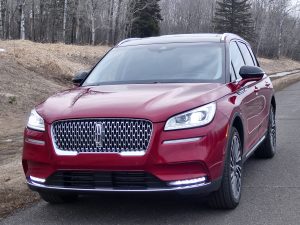
But in the space of one year, here we are evaluating — and praising — the third of three Lincoln SUVs all of which have carved out prominent places in the hierarchy of U.S. luxury sports-utility vehicles.
The new Navigator was deserving of high praise, and it was followed, barely a month ago, by a review of the entirely new Aviator, which I declared might be the best of U.S. luxury SUVs with its exceptional 3-row luxury as well as performance, tucked inside an extremely stylish exterior. And now, along comes the Corsair — Lincoln’s stylish example of what a compact, 2-row SUV can be, when a company puts its unrestricted mind to it.
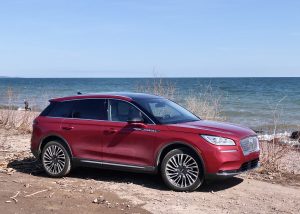
As someone who tries to be as objective as possible in evaluating any and all new vehicles, I had to admit the Navigator was bigger and heftier than I would choose, but its upscale luxury features made me realize why high-buck buyers would be drawn to it. The Aviator came wrapped in sheet metal that was attractively styled and the interior was loaded to the hilt with luxury pieces that made it expensive, but reasonably compact for a family that needed a 3-row SUV and still wanted something sporty and with surprising performance.
The Lincoln Corsair, on the other hand, fits like a glove my personal preferences for a compact SUV with adequate room for four or five and some baggage in its 2-row configuration, and it puts its tight and sleek styling to work in a sporty package that maneuvers easily, turns in a tight-circle u-turn, and will scat and run with the quickest of the compact SUVs. The competition is ferocious in the compact SUV realm, where Ford’s Escape is one of the standard bearers, and faces the likes of the Toyota RX4, Honda CR-V, Chevrolet Equinox, BMW X3 and numerous others, from virtually every manufacturer.
Since everybody seems to want an SUV these days, it makes sense that the majority of buyers might want to keep it compact when choosing, hoping to get improved fuel economy and making it easier to lure some performance out of smaller powertrains. The Corsair meets both ends of that bargain, delivering nearly 30 miles per gallon and still delivering some starch when you hit the gas.
Turbocharging is responsible for the compromise, with both Corsair engines, Ford’s 2.0 and 2.3-liter 4-cylinders gaining power from the forced-air feed of the turbos. The test-vehicle I drove was the loaded model, with a 2.3-liter turbo delivering a potent 295 horsepower and 310 foot-pounds of torque. That gives it about a one-second edge over the 2.0, with its 250 horses and 280 foot-pounds, in a 0-60 dash.

Taking a page out of Aviator’s book, the Corsair doesn’t have as flashy a dashboard design, but it does have similar bucket seats, with excellent support and 24-way power adjustability, with a curvaceous design that puts it up at the top of its class for comfort. The smooth leather seats have push-button heating and cooling ventilation, and add the therapeutic massage feature of its bigger siblings.
Lincolns have traditionally swiped the best features from Ford vehicles, and the Corsair wasn’t about to let the flashy new Escape get away with all its stuff, starting with its new and unique platform. The Corsair rides comfortably on the Escape chassis, which is firm in design which aids stability and sporty but safe handling. In its previous round of vehicles, Lincoln had the MKC sedan, which was nice, attractive, but was not an SUV.
The Corsair has the slightly taller stance and all-wheel drive, with all that high-end interior equipment and it is an SUV, retaining its flair for utility, even if compact and eye-catching.
One thing that takes a bit of getting used to is the shifter. Eliminating the console stalk to select gears gives occupants a bit more room, and Lincoln resists the temptation to go with the current and trendy norm of a rotating dial. Instead, on your first time inside and behind the wheel, you might spend a few minutes searching before you spot the location, just under the ledge of the center stack, where push buttons can activate reverse or drive or neutral to control the 8-speed automatic. Only problem, you can’t really see the buttons, so it helps if you know where they are.

If the front buckets are supremely comfortable, and encapsulate you as if in a cocoon, the rear seats will slide to add to the quite roomy comfort in the rear. And it helps all the seats that the sunroof is one of those full, panoramic roofs that seems to open the whole ceiling to the outside.
Both models of the Corsair offer all-wheel drive, with the more basic model starting at about $39,000 and the upgraded Reserve model starting at almost $46,000. My test vehicle came loaded up with nearly $15,000 in optional equipment and packages, reaching over $62,000, which maintains its $6,000-$8,000 price status above the base model.
Among all those upgrades are some serious luxury touches, such as LED lights for added brightness in every application. Headlights, taillights and foglights are all LEDs, and it even has what are called approach lights, which give you a little lighted grid on the ground outside the doors to make sure you realize you’re getting into the right vehicle.
I’ve always been an advocate of getting the smallest vehicle that is big enough, and the Corsair is the perfect example of what I was getting at. It will do everything larger SUVs will do, but with the added convenience of agility and maneuverability in traffic and congested driving.
As for the styling, the Corsair has a lot of cues from the larger Aviator, with that distinctive Lincoln grille fitted in between the headlight fixtures, and a side view featuring contour lines blending into the sheet metal on both sides, and large, stylish alloy wheels, with dual exhausts. A nice added touch on the rear is a horizontal taillight that runs the full width of the vehicle and makes a distinctive impression on anyone approaching from the rear, or coming upon a parked Corsair.
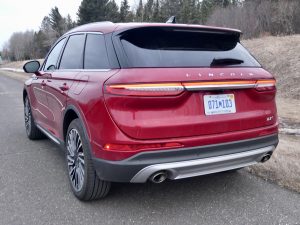
Built to slide, the rear seats offer comfort and added fold-down storage flexibility.
Maybe most people choose more compact SUVs because they cost less, but if things keep going the direction of the Corsair, we might have to start paying more to get all that styling into a smaller package.


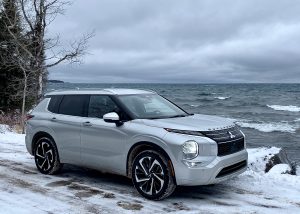
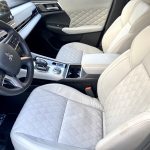
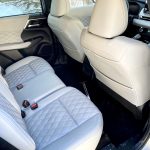
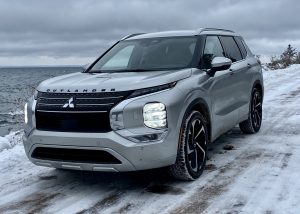
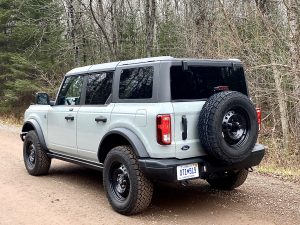
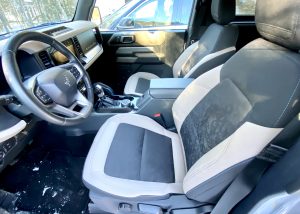

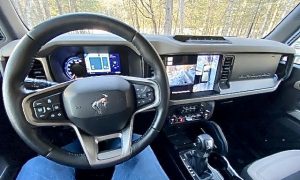
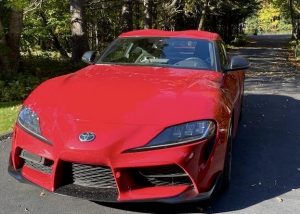
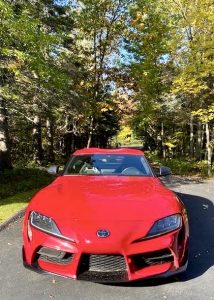

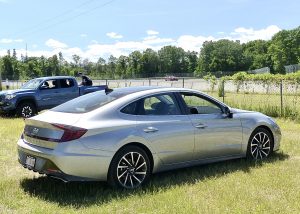
 John Gilbert is a lifetime Minnesotan and career journalist, specializing in cars and sports during and since spending 30 years at the Minneapolis Tribune, now the Star Tribune. More recently, he has continued translating the high-tech world of autos and sharing his passionate insights as a freelance writer/photographer/broadcaster. A member of the prestigious North American Car and Truck of the Year jury since 1993. John can be heard Monday-Friday from 9-11am on 610 KDAL(www.kdal610.com) on the "John Gilbert Show," and writes a column in the Duluth Reader.
John Gilbert is a lifetime Minnesotan and career journalist, specializing in cars and sports during and since spending 30 years at the Minneapolis Tribune, now the Star Tribune. More recently, he has continued translating the high-tech world of autos and sharing his passionate insights as a freelance writer/photographer/broadcaster. A member of the prestigious North American Car and Truck of the Year jury since 1993. John can be heard Monday-Friday from 9-11am on 610 KDAL(www.kdal610.com) on the "John Gilbert Show," and writes a column in the Duluth Reader.